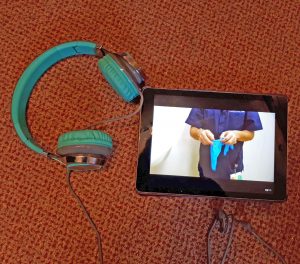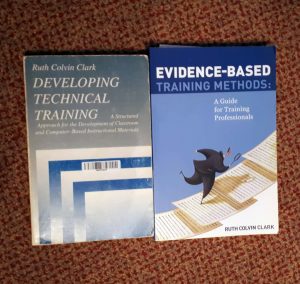Learning in style
First published in Health and Safety at Work Magazine, March 2017
Is it useful to categorise students according to their “learning styles” during safety training? Bridget Leathley considers what trainers need to know about the facts and fiction of a controversial theory.
Learning preferences
You may already be aware that some colleagues will learn how to do a risk assessment only if you show them, while another would prefer you to describe it, and a third needs to know the theory behind it before they even consider having a go. Considering your own continuing professional development (CPD) might reveal preferences for a particular learning style. Do talking head videos on YouTube meet your needs, or would you prefer a podcast? Would you prefer to talk an issue through with someone before deciding on a course of action, or are you happy to go to the internet and read the source documents?
How human beings learn best has been debated for centuries. In the 5th century BC, Plato encouraged students to prepare for learning with music and gymnastics; while in the 4th century BC, Aristotle advocated education through play. Making people sit at desks in rows and learn by rote seems to have been a Victorian invention to bring the masses to a minimum level of education. Towards the end of the 20th century we replaced blackboards with overhead projectors and acetates; in the 21st century, we turned to PowerPoint slides and laptops. Teaching styles have continually developed to reflect the available technology.

The 20th century also saw a vogue for research into theories that each student (adult or child) can be categorised into a variable number of groups, and that by categorising them we can know better how to educate them. In 1909, George Herbert Betts – a teacher and author who largely focused on the development of religious education – published a 150-item questionnaire to determine student’s strengths in seven types of “imagery”: visual, auditory, cutaneous, kinaesthetic, gustatory, olfactory and organic. “Cutaneous” refers to the ability to think about how substances feel; “kinaesthetic” relates to physical activities and the sensation of movement; “gustatory” relates to tastes; “olfactory” refers to smells; and “organic” refers to imagining sensations such as hunger, fatigue or pain. However, even though his experiments showed that some people were stronger than others in different areas, Betts decided the decisive factor in test scores was in fact due to “a difference in general retentiveness, ability to learn, etc”.
Nevertheless, others took Betts’ ideas, discarded the gustatory, olfactory and organic categories and renamed “cutaneous” as “tactile”. Out of this came one of the more popular learning theories today, developed by Rita and Kenneth Dunn in 1978 – that by labelling people as visual, auditory, kinaesthetic or tactile learners (VAKT), we can devise more effective learning programmes (see box “VAKT and VARK” below).
Why does it matter?

There have been many other attempts to label learners in different ways. In a systematic and critical review of research investigating learning styles in post-16 education in the UK, Frank Coffield, a professor at University of London’s Institute of Education, and colleagues identified no fewer than 71 different schemes for categorising learners. Of the 71 theories, they identified 13 as worthy of consideration.
Why might learning styles matter? Two extremes of theory emerge. Some educationalists believe that the learning style of a learner is fixed, and that nothing that can be done to change it. Therefore, as the teacher or trainer, you should determine the preferred learning style of your learners and teach to that style. As you are likely to be faced with more than one learning style in any class, the dilemma is how to present the same idea in more than one way, and how to accommodate each style without getting repetitive.
Others tend to the view that while people start with a learning preference, this should be regarded as a personal weakness that the teacher can help them to overcome. If you prefer to watch TV news, I will encourage you to read a newspaper or listen to the radio news; if you prefer hard facts, I will suggest you try philosophy.
If the first of these theories were true, you would expect there to have been some studies where a random selection of people taught in their preferred learning style performed better at tests than those taught in a style which did not match their style. This has been called the “meshing” hypothesis. However, no studies performed have been able to show this. American academics (Pashler et al, 2008, published in Psychological Science in the Public Interest) reviewed studies which had made use of a variety of different learning style models. They found that while adults and children are more than happy to express a preference about how they like to learn, there was little evidence that those taught according to their preference will perform better in any test of understanding than those taught against their preference.
Is absence of evidence, evidence of absence?
Neil Fleming, academic and author of the VARK questionnaire, responds to the criticism that there is no evidence by quoting Donald Rumsfeld in his search for weapons of mass destruction: “The absence of evidence is not the evidence of absence.” Fleming argues that since there is no evidence of harm in applying learning styles, criticisms based on lack of empirical evidence are not helpful.
The Chartered Institute of Personnel and Development (CIPD) has a softer version of the two extreme theories above, which is therefore more difficult to prove or refute. In its factsheet “Psychology and neuroscience in learning”, the CIPD states its belief that “encouraging an awareness of an individual’s own thought and learning processes … [is] perhaps the most important advantage of applying learning theories from neuroscience. Learners who are aware of a range of different learning strategies are more likely to better prepare for their learning experience.”
This softer version – which suggests that people have a learning style preference, rather than a fixed style – is more commonly used by health and safety practitioners. Rob Burgon, workplace safety training manager for Royal Society for the Prevention of Accidents (RoSPA), makes use of the VARK model when preparing courses, saying: “We do bear in mind the learning styles and have them ‘ready mixed’.”
Paul Smith, a health and safety trainer and former HSE inspector, similarly uses a recognition of these learning styles to plan “something for everyone” in training sessions. By showing the class some burnt out switch gears, he stimulated visual, tactile and (returning to Betts’ original classification) even olfactory learning, as the smell of burnt out equipment filled the classroom. However, the use of props in training sessions tends to gain the attention of most students, regardless of their assessed mode of learning.
Research supports Towlson with this idea. A study in the journal Brain and Language (by Constantinidou and Baker, 2002) found that, regardless of measured preference for visual images, all adults could benefit from the use of appropriate images in presentations. Common sense supports this idea. Imagine you have three things to teach a new fire warden: how to recognise a fire alarm call point; how to distinguish between the fire alarm and the security alarm; and how to use an evacuation chair. Most people would, respectively, deploy a visual, auditory and kinaesthetic approach.
Alistair Bromhead, who runs a manual handling training company, believes variety is the key. “Regardless of the type of learner that someone is or claims to be, their attention level will fade after a certain amount of a given activity.” Bromhead uses the VARK categories as a guide, and encourages working in small groups.
In practice
The review by Coffield et al had concluded that a Learning Style Questionnaire (LSQ) devised by Peter Honey and Alan Mumford in 1986, which divides students into activist, reflector, theorist and pragmatists, is “a poor measure of learning”. (See box “Learning Style Questionnaire”, below). However, Smith believes that it can be useful for trainers to be aware of the four LSQ categorisations, explaining that he has learnt to recognise theorists in his classes, and to take the time to give them the background information they need before they will engage fully with the learning.
Tim Briggs, health and safety course leader at Leeds Beckett University, also prioritises an awareness of teaching styles over learning styles. “It doesn’t matter which learning style theory is used. It’s how learning is delivered,” he says. Briggs does not see categorisations such as VAKT and reflectors/activists as the means to fixing student learning styles; rather they are ideas to influence and broaden delivery styles. The advantage of teaching on a degree course is that there is time to get to know the students. “It allows the teacher to use a mix of different delivery styles in each teaching period, to involve all the learning audience so that they participate in their learning,” he says.
In Ruth Colvin Clark’s book for workplace trainers, Evidence-based training methods, she warns of the detriment to learning when too many delivery modes are mixed in an attempt to accommodate all learning styles. Fleming, the author of the VARK scheme, also makes it clear on his website that VARK is not intended to make teaching or training delivery more difficult. “There was no intention of challenging teachers to teach everything four ways,” he says. Instead, teachers should simply “vary their teaching strategies to provide more variety”.
David Towlson, director of training at training and consultancy company RRC International, believes that “learning styles” is mostly an unhelpful framework for trainers. He argues that trainers should not confuse the rigid classification of learning styles with differentiation, or the need to reflect different students’ needs. “I do believe in differentiation to adapt learning to different students – it’s obvious that different people need different support. But let’s not confuse that with learning styles.”
Towlson also adds that learners should be “encouraged to use styles which are unfamiliar to them to encourage ‘whole brain’ learning.”

Research supports Towlson with this idea. A study in the journal Brain and Language (by Constantinidou and Baker, 2002) found that, regardless of measured preference for visual images, all adults could benefit from the use of appropriate images in presentations. Common sense supports this idea. Imagine you have three things to teach a new fire warden: how to recognise a fire alarm call point; how to distinguish between the fire alarm and the security alarm; and how to use an evacuation chair. Most people would, respectively, deploy a visual, auditory and kinaesthetic approach.
Alistair Bromhead, who runs a manual handling training company, believes variety is the key. “Regardless of the type of learner that someone is or claims to be, their attention level will fade after a certain amount of a given activity.” Bromhead uses the VARK categories as a guide, and encourages working in small groups.
References
Frank Coffield, 2008. Just suppose teaching and learning became the first priority…
Frank Coffield, 2013. Learning styles: time to move on
Patrick Carroll, 2022, Learning Styles Don’t Actually Exist, Studies Show
